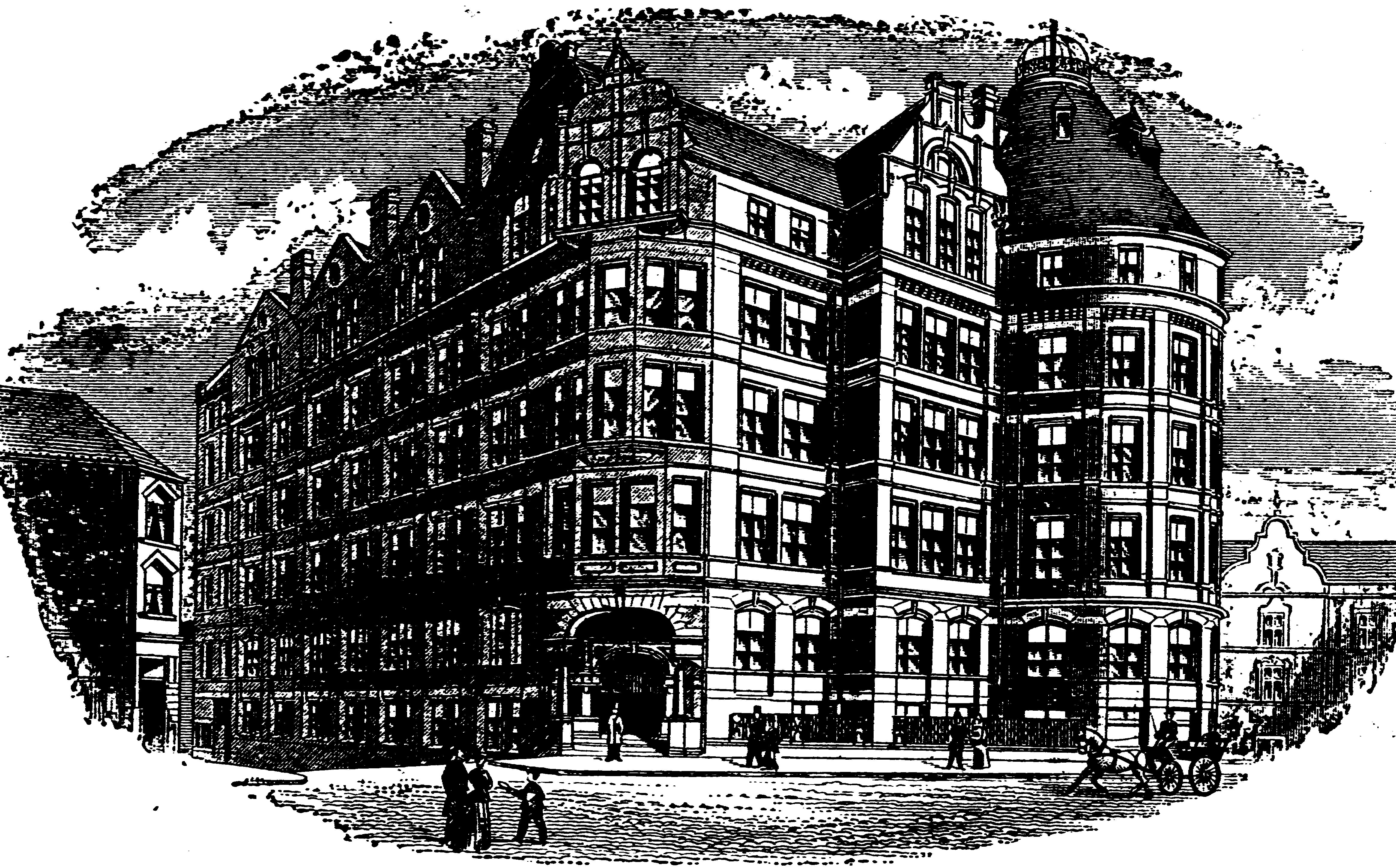 J. & W. Campbell
& Co.
J. & W. Campbell
& Co.
 J. & W. Campbell
& Co.
J. & W. Campbell
& Co.
J. & W. CAMPBELL & Co., Warehousemen, Ingram Street, Glasgow.
A review of Commercial Glasgow, as it presents itself in this busy closing decade of the nineteenth century, would indeed be incomplete if we omitted to take note of the great firms of warehousemen which have contributed so materially to the present pre-eminence which the City holds as the metropolis of industrial enterprise in the Northern Kingdom. One of the most important firms, owing to the wealth it represents, the number of hands it employs, and the extent of its commercial connections, is the old-established house named at the head of this sketch.
Messrs. J. & W. Campbell & Co. date back in the foundation of their business to the year 1817, when the concern was established by James (afterwards Sir James) and William Campbell. To their efforts and personal character is due no small share of the great success which their house has subsequently achieved in the commercial world, there has been a diminution in the mercantile ability displayed in the control of the organization at a later period ; on the contrary, the present proprietary have still further developed the possibilities, and augmented the former successes, of the house ; nevertheless, the chief credit must be allowed to the shrewd and enterprising men who, in the midst of the severest competition, fought their way to the premier position in the trade of Glasgow.
From the Saltmarket, where the business was established, Messrs. J. & W. Campbell & Co. removed their ever-increasing enterprise to Candleriggs, where the process of development continued with unabating force and regularity. The present premises were completed in 1856, having been specially designed to meet the exigencies of Messrs. J. & W. Campbell & Co/s trade, and it may safely be affirmed that there will not be found, throughout the length and breadth of the United Kingdom, a more architecturally interesting or from a commercial point of view more complete structure associated with the dry goods industry of modern times ; and, though planned and erected thirty-four years ago, the warehouse is in no single respect inferior to the most modern edifices : a circumstance which speaks volumes for the foresight and discrimination of its chief designer, Sir James Campbell. The building is a very fine specimen of the Scottish Baronial style, its massive frontage giving the establishment a most commanding prominence in Ingram Street.

Descending to the basement, well raised above the street level, and possessing an admirable supply of natural light, we find ourselves in the heavy goods department. Here are endless varieties of flannels and blankets, shirtings, tickings, waterproof fabrics, moleskins, cotton linings, grey cottons, towellings, sackings, carpets and floor-cloths, and other goods of a similarly heavy character. Tweeds and other woollen cloths are stored on the first floor, and probably in no house n the Kingdom will a more representative stock of these goods be found. On the same floor are the departments of cotton damasks, prints and cretonnes, all kinds of plain and fancy hosiery, Irish linens, calicoes, white shirtings, napery, yarns, gloves, and manufactured woollen goods. Ascending, by means of a handsome staircase, to the second floor, a large and comprehensive stock is displayed, embracing the newest designs in coatings, jacketings, tartans, ulster materials, dress goods in all the newest styles and fabrics, collars, cuffs, scarves, shirts, and haberdashery. In the ready-made clothing department a very valuable selection of goods is at all times held, embracing all newest designs and most fashionable materials. On the third and top floors of the warehouse will be found the silks, satins, ribbons, laces, flowers, fancy goods, small wares, umbrellas, fans, bags, mantles, millinery, shawls, skirtings, ladies' underclothing, lace and muslin curtains, and a host of items of hardly less interest. Indeed, merely to set foot within this commodious warehouse is sufficient to supply, better than any descriptive article, an approximate idea of the magnitude of the business transacted, as well as the thorough organization required in every department.
The founders of the business were gentlemen of the highest commercial attainments and character, estimable only by reason of the great influence they wielded in the mercantile circles of Scotland, but also on account of the important public services rendered by them in promoting the interests of their City. In 1831, Mr. James Campbell was elected a member of the Town Council ; in 1840, he became Lord Provost of the City ; and, in 1842, he received the honour of Knighthood at the hands of Her Majesty, on the occasion of the birth of the Prince of Wales. In 1847, Sir James Campbell purchased the estate of Stracathro. On 10th September, 1876, he died, at the ripe age of eighty-six years, leaving two sons, who have rendered eminent services in the councils of the Empire. Mr. J. A. Campbell, LL.D., of Stracathro, is Member of Parliament for Glasgow and Aberdeen Universities, while his brother, Mr. Henry Campbell-Bannerman, creditably filled an important position in the last Liberal Government of Mr. Gladstone.
The personnel of the firm at the present day is made up of Mr. James Campbell, of Tullichewen, and his nephews, Messrs. William A. Campbell and Matthew Pearce Campbell. The whole business furnishes one of the most forcible illustrations in modern times of the possible achievements of well-directed energy, enterprise, and mercantile capacity.
Back to Index of Firms (1891)